Download “Strickly for Fun” Crew Manual
Transcript
“Strickly for Fun” Crew Manual 1. Purpose The purpose of this manual is to provide you with an overview of the operations of the items you will probably operate on the boat. Everything on a boat is a little different from on shore, so please ask when first using anything, even opening the refrigerator door is different! General notes: Determining when to run the generator is a task left up to Scott or Teri. Therefore it is best to ask Scott or Teri before using high electricity consuming items. The air conditioner and heater are high consumers so do not adjust thermostats. Washing machine/dryer, also they use lots of water and create lots of gray water. Regular oven. Water heater. Hair dryers and hair curlers. Water maker. At anchor we normally run the generator during evening meal preparation. If the batteries are low from the night before, we run the generator in the morning. Topics covered: 1. 2. 3. 4. 5. 6. 7. 8. 9. 10. 11. 12. 13. 14. 15. 16. 17. 18. Purpose................................................................................................................1 Safety Tips...........................................................................................................2 Boarding and on-deck ..........................................................................................3 Saloon .................................................................................................................4 Galley General.....................................................................................................5 Galley Cooking....................................................................................................6 Food Life & Galley hints: ....................................................................................7 Head ....................................................................................................................8 Staterooms...........................................................................................................9 General Entertainment ..................................................................................10 Books, Music, Movies, Radio ........................................................................11 Card Games ...................................................................................................12 Chess Games .................................................................................................13 Using the Dinghy ...........................................................................................14 Dinghy problems ...........................................................................................15 Going Ashore-Shopping.................................................................................16 Pickpocket & theft protection.........................................................................17 Wading, Swimming, Snorkeling and Diving ..................................................18 Crew Manual Page 1 of 18 9/10/2007 2. Safety Tips General: You need to pay attention and think safety at all times. Unlike shore, the boat can move at any time even at the dock from a boat ‘s wake. It is a good practice is to always hold onto something when moving or on deck. The most important boating rule is: one hand for the boat, one hand for you! You can always tell an experienced boater, they always are holding on. Do not touch any metal during a lighting storm. When on deck: One hand for the boat, one hand for you! Wear a life vest whenever on deck at night, when working, or the water is rough. Always wear rubber sole close toe footwear on deck. (Scott got to visit the hand surgeon when he did not do this!) Always have someone watch you when on deck. Keep your hands and feet clear of the windlass and the chain/rope (rode). Be careful to not accidentally press the windless button next to the windlass. When handling the anchor or raising/lowering the dinghy wear gloves. Never ride on the dinghy when being lowered. Dinghies sometimes fall. Pilothouse: At night protect the watch standers night vision by not turning any lights on. Do not play with electrical switches. Do not run the RADAR near a harbor. Saloon: At night protect the watch standers night vision. Do not turn bright lights on. Be careful whenever going up or down the stairs they are steep. Galley: Remember: one hand for the boat, one hand for you! Wear rubber soled footwear when cooking. Wear apron when working with hot liquids. When leaving the stove, even for a second, turn it off. Use the metal pan holding bars to hold all pans if you let go of handle. Adjust bars around pan before filling the pan up. Pour all liquids over the sink. Move all pots, bowls over the counter, not the floor, so you will not slip on a spill. Turn the gas switch off and let the flame burn out before turning off the burners. When putting anything in/out of the oven always use barbeque mitts. Engine room: One hand for the boat, one hand for you! Do not wear lose clothing in the engine room-gets caught in moving equipment. Many things are hot, be careful where you place you hands, legs etc. Wear hearing protection and glasses whenever an engine is running. Crew Manual Page 2 of 18 9/10/2007 3. Boarding and on-deck Boarding: The preferred boarding location is from the swim platform at the end (stern). The second location is the right (starboard) side. When loading luggage or groceries ask for help and hand it across, then follow. Leave your shoes at the door to the saloon. Now would be a good time to put on your new/clean boat shoes. Swimming: Bring a towel from your bathroom (head). Rinse using the hose inside the deck (cockpit) but stand on the swim platform. Going forward: Go forward on the right (starboard side). Let helmsman know you are going forward. Do not block the helmsman view. Avoid the anchor chain and the windlass. This device brings up the anchor. Boarding the dinghy: Pull the dinghy to the swim platform. Tie it tight/hold it tight against the swim platform. Step onto the tube and then step in to the dinghy. Exiting the dinghy: Pull the dinghy to dock. Hold it tight against the dock. Make sure the dinghy is locked up. Take everything/hide everything from thieves! (Big problem) Step onto the tube and then step in to the dock. Crew Manual Page 3 of 18 9/10/2007 4. Saloon Safety Equipment: Fire blanket & fire extinguisher are in the lower cabinet in column. Starboard of the TV near the floor. There is a flashlight there also. Washing machine and dryer: Though small, the washer and dry can be used to clean clothes. When docked we may use the shore laundry and do all loads at once. Light Operation-Dimmer On: quickly press the button light and it will gradually get bright. To turn the lights off press the button quickly. When you hold the button it changes intensity (either up or down). Press it a second time to change direction of change. Air conditioning and heating This is handled by Scott or Teri Air conditioning / heating requires that either the generator is running or we are hooked to sufficient shore power. Inspect protection: Spray dock lines. Place Boric acid on all food shelves and bookshelves. Place roach traps out before needed and before they reproduce. Spray Screen Pruf on cloth and rub both sides of screens. If we have a water maker failure and are not near water supplies. Water conservation tips – washing dishes. Wash dishes by placing a little soap on handiwipe and wipe dishes Rinse in salt water. Rinse with a cup of water and let water run on next dish. Showers. Wet down, turn off water, soap up, rinse. Head. The master head will be switched to use salt water. Crew Manual Page 4 of 18 9/10/2007 5. Galley General Information Stores list: Because there are no grocery stores at sea we need to plan our meals. Please check with Teri on what you are going to use to cook. We do not want to run out of some key ingredient by accident. Snacks: Are available in the cupboard next to the refrigerator. Can be eaten at any time. Refrigerator and freezer: To open the door--release the lock on the top of the door. Open the door very slowly and stop items from falling out. Something usually falls out when at sea! When placing something in the refrigerator please make sure it will stay standing and will not fall out. If necessary the retaining rods unscrew to allow for the removal of items. Galley Sink: Do not waste water by letting it run when it not needed. Water is not a free resource on our boat. Soap is under the sink. To scrub non-stick pans use soap and a sponge. Wash all dishes then rinse all dishes in the second sink, and dry. In tropics at dock/anchored place Borax in drain at night to kill roaches. Sanitize dishrags, sponges in microwave for 30 seconds on high. Garbage: If our location requires or allows recycling--please do so. If at anchor, ALL garbage should be placed in trash compactor. Plastic and glass is always placed in the trash compactor. Paper, organic and aluminum cans can be disposed @sea if >12 miles out. Trash Compactor: Runs for one minute. No pressurized aerosol cans, completely depressurize before discarding. Never push trash in compactor, there maybe shards of glass or metal. Place bottles & cans on their side in the center of the compactor. Place paper on top of messy items to keep ram clean. Turn switch to start and hold until the compactor runs. If ram jams, turn switch a second time, this will raise the ram. When replacing the trash bag - Button Bag carefully to side. To stop from tearing new bag, do not turn on until new bag is full. Clean Ram as each bag is replaced with paper towel Crew Manual Page 5 of 18 9/10/2007 6. Galley Cooking Microwave: Works just like your home one, press the time and then cook. To lock/clear lock press Clear/Off for 3 seconds. Wear gloves if boiling a liquid, it could cause a burn. Stove (propane): For YOUR safety please wear waterproof apron. Place empty pan on burner and adjust metal bars to hold. Remove & fill pan in the sink and then place the pan on the stove. Always move/carry pans, etc over the counter not over the floor. If it spills on the floor, wipe immediately. When ready to cook confirm all burner controls are off. Turn on 12v lp circuit breaker marked LP Turn on 120v circuit breaker marked cook top Turn on solenoid (wall switch labeled gas, port side of stove top). Turn burner on, wait 5 seconds for burner to light, if it does not start-stop. To turn off: turn off wall switch, wait for burner to go out, turn off burner. Do not leave the stove unattended for even a second. The left burners have extra low setting. The left burners do not work without power. If power failure both left burners must be turned off before on. Main oven (electric): For safety please wear waterproof apron and oven gloves. A wave will knock your hands against the oven wall. It is electric so let Scott or Teri know so we can run the generator. To lock out oven, press and hold Cook Min/Hr and Stop Time. Hold 6 seconds to turn off lockout. To turn oven off, press cancel. To change temp, press bake and then +/-. Clean window before cleaning oven, to protect glass from discoloring. Crew Manual Page 6 of 18 9/10/2007 7. Food Life & Galley hints: Shopping: While on the dock change packaging to plastic containers from the boat. Do not bring cardboard, paper food packaging on board (holds roach eggs). If tropical location-nothing is stored in original container use boat containers. Except for cans, sealed plastic, and strong glass containers. This also limits the amount of trash to throw away. Soak CAN and BOTTLES in tropics so roaches do not board. Soak fruit and vegetables in a bucket of seawater on the dock for 20 minutes. Then rinse in fresh water and dry. Stops from ripening too fast. Bananas and pineapples are especially likely to contain cockroaches. Produce: If food has never been refrigerated, it will last longer not in the refrigerator. To extend life wash produce in a gallon of fresh water and bleach. 5 drops to quart, 1 teaspoon to a gallon. Then rinse in fresh water. This kills the existing fungus and mold on the produce. Wrap produce and fruit in newspaper will last longer. Eggs: Should be bought un-refrigerated, and boiled for 7 seconds. Or coated with a light coating of oil. Store them in the plastic holders we have and rotate 180° every 3 days. Bread: Purchased un-sliced. Brush with red or white vinegar, let dry and store in a paper bag. Flour, pasta, rice: Should be microwave-ed in box for 20 seconds on high-sterilizes. Fruit & Vegetables: Check every day for spoiled fruit and use or discard. Wrap in newspaper. Spray the skin with vinegar to last longer. Dried fruit is good. Greenbags absorbs ethylene gas. 800-372-3610, www.greenbags.com. Wrap oranges, lemons, limes in foil should last 2 –3 weeks. Meat: Canned meat is pretty good. Pepperoni, sausage and dried meats last a long time. Dairy: Hard cheese sealed in wax lasts a long time. UHT milk is good to cook with, taste is ok. Too pasteurize milk, heat it to 144 degrees for 30 minutes, freeze cool. Misc: Socks over bottles prevents noise. Store aluminum foil in plastic bags to prevent rusting. Place damp towels under bowls to prevent sliding. Grow Mung Sprouts. Shopping list: We will be shopping in unfamiliar grocery stores Still grocery stores arrange foods by type. We will arrange our shopping list by categories. Meats, Dairy, Fresh, Frozen, Dry, Canned, Household, Other. Start in warehouse (Sams or Costco) stores then go to grocery stores. Bring a calculator to allow converting measures and money. Bring foreign language dictionary to help translate food. Crew Manual Page 7 of 18 9/10/2007 8. Head Toilet Males sit when using the toilet (for safety and cleanliness). A smelly bathroom is a really good way to get seasick! The wood floors become permanently smelly. Only toilet paper goes in the toilet bowl. Boat toilet drains pipes are _ size of home one! Bags are provided for feminine hygiene products. If there is paper in the bowl before you use it, flush before using. When replacing the toilet paper squeeze the roll a little–to keep it from unraveling The handle on our toilet is an electrical micro-switch and is not very strong! It is not like a home one that requires really pushing. To Flush press the level down GENTLY. Sometimes requires two flushes. To remove water pull the level upward. If head seems plugged, just pull up on the handle. Every couple of days and on entry / exit to ports do a couple empty flushes. Electric pump out. Confirm the outlet valve is open or you rebuild the pump out pump YUCK! Then turn circuit breaker on. Turn the timer in the panel to the level shown in the master stateroom. Monitor on panel, when green turn off. Pump can run dry for only a few minutes Manual Pump: Make sure valve is open and use short rapid strokes. Sink: Do not let the water run when brushing teeth etc. Shower: Let Scott or Teri know, we may need to run generator for the water heater. Turn on shower blower. Turn on shower. Turn water handle to 12 o’clock for correct temperature when underway Else turn to 10 o’clock when not underway. Take a 3-5 minute shower. Porthole: (window) Only open if at a dock or at anchor, and REMEMBER to close when you leave. If not you will have a very wet bathroom (head) for the rest of the trip. Cleaning: Cleaning supplies are under the sink. You are responsible for cleaning your head. Use only Simple Green in the toilet. Crew Manual Page 8 of 18 9/10/2007 9. Staterooms Storage: There are two small closets (hanging lockers) to hang items. There are cabinets above the bunk and above the desk. Please place your glasses and such in the nightstand, not lose on the ship. There is a bunk bed in your room that can be used for kids or storage. Do not place anything in the bunk that will hurt if it falls on you! Flashlight: (There are four in your room) The blue flashlight on the nightstand is always on (dimly as a nightlight.) To increase brightness press and hold the button. There are 7 brightness levels. There are two headlights in the nightstand. These are your primary lights. Push the button once for a dim green, keeps night vision. Please use this light when walking around after lights out. Press the button again for 2 white LED’s, to read with etc. this will ruin your night vision, but will not wake sleeping partner. Press the button again for bright white light, this will ruin everyone’s night vision, so cover lens before turning the light off. If you use any flashlight much let us know so we can replace the batteries. Alarm: Use this to make sure you show up for your watch. There is an alarm clock on the nightstand. To set the time, push the Plus/Minus button. To set an alarm push the button on the right side all the way in Until the bell blinks. Then pull the button to the outside until the bell is visible and not blinking. Porthole: PLEASE ask Scott or Teri before opening. Only open if not too rough, and REMEMBER to close when you leave. If you leave the porthole open - waves will make your bed very wet! Temperature: Please ask Scott or Teri to adjust the temperature, affects electrical needs. Cleaning: Please keep the bed made. Please do not leave anything on the floor of your room. Sometime we need to lift the floorboards in your room. Cleaning supplies are under the sink in the bathroom (head). Crew Manual Page 9 of 18 9/10/2007 10. General Entertainment You will be surprised at how fast time will pass on our voyage, and how quickly you will settle into the routine of life at sea. When you are not on watch you will probably spend your time reading, chatting, watching a movie or sleeping. In addition to exploring, shopping, walking, there is swimming, snorkeling, scuba diving, and going for boat rides in the dinghy. Exercise: Standing on a moving vessel is a lot of exercise, as is snorkeling and walking. Computers: Of course we have multiple computers on board to learn or play with. We also carry a digital camera, which you can use to send pictures to friends (from port). Astronomy: Star gazing from the center of the ocean with no lights is incredible. We have star charts and will help people learn the constellations. Boating Education: Learn how to operate the while it is tied to a docked. We are looking for people to stay on the boat when we are not on the boat or learn about operations at sea, navigation and boat maintenance. . We will leave the boat docked for weeks at a time in the Mediterranean. Ham Radio: We have a ham radio receiver and a ham radio receiver / transmitter. (When transmitting in a foreign country we need a reciprocal license. This requires us to bring a copy of our ham license, transceiver name, serial number, output watts, frequency range) Site Seeing: We have four pairs of binoculars that you can use to watch birds, dolphins, view islands other vessels etc. Crew Manual Page 10 of 18 9/10/2007 11. Books, Music, Movies, Radio Books: You should bring along a few books to read. We have 100 of our favorite best sellers on board. Ask for a current list. We also have quite a few books on boating, weather, celestial navigation etc. We also have many boating, scuba diving and oceanography books on board. Music: We have 5 portable MP3 players with over 1000 songs. We have a lot of Rock & Roll, Jazz, Smooth Jazz, some island and some pop. Feel free to bring you own CD’s and CD player and extra batteries! DVD’s : There is a DVD player in the saloon, one in the pilot house, and a portable PC that plays DVD’s in the guest stateroom. We usually bring about 100 DVD’s with us. Radio We listen to broadcast radio for news. When close to shore (50 miles) we can pick up FM stations. Within 100 miles or so we can pick up AM stations, even farther at night. Father out we listen to Short Wave Radio. We have a sensitive short wave radio in the pilothouse (SSB). News - Canadian Broadcast Corporation (CBC) 6070, 6160 (24 hours) Service BBC AFRTS UTC EST EDT Freq 0-1 4-5 5-6 11810 0-4 4-8 5-9 5975 1-3 5-7 6-8 11835 (summer) 1-4 5-8 6-9 9525 3-5 7-9 8-10 11835 4-5 8-9 9-10 5975 4-6 8-10 9-11 6135 10-14 14-18 15-19 6195 11-14 15-18 16-19 15190 15220 14-17 18-21 19-22 15190 17840 21-24 1-4 2-5 5965 4279 USB 12690 USB 6350 10320 Atlantic 5765 13362 Pacific 6459 Gulf of Mexico Crew Manual Page 11 of 18 9/10/2007 12. Card Games You are welcome to use these items outside, however these items can be damaged by water, so please do not let them get wet. Magnetic Cards – 1 Deck and magnetic card holder. Solitaire/Poker (Excalibur Casino-2 AAA batteries-small Phillips) This item has a small display so glasses are useful. To turn on: Hold stylus. Press the On/Off. Press New Game to start a game (and kill the noise) Turn off the sound by pressing the speaker icon in the lower right. When the sound is off the note in the upper left corner goes away. Turns off after two minutes. When turned on it remembers last game. To reset: use the stylus to push the reset button. To pick a game: select Solitaire: The New Game icon cycles between solitaire, draw Poker & deuces wild. You can tell it is set to solitaire by the word solitaire being displayed. To cycle between deal options: Pull once on the enter/deal/draw key and then press $ icon. Unlimited passes thru deck 1 card at a time (Standard Deal 1) Unlimited passed thru deck 3 cards at a time (Standard Deal 3) One pass thru deck 1 card at a time (Vegas Deal 1) One pass thru deck 3 cards at a time (Vegas Deal 3) To deal: Pull the enter/deal/draw button down. To move a card: touch the from location icon and the to location icon. It will take a few minutes to get used to no suit colors. Cards: Queens look like a zero… and Diamonds look like a small zero. POKER: Select Poker: Push new game icon until Draw Poker displays. Press enter to confirm your selection. Betting: Press Bet + to increase your bet, Bet – to decrease your bet. Dealing: Press deal to get a new hand. Discarding cards: Select the card to keep by pressing on them. Then press deal to get new cards Did you win: Press deal to see if you won. DUCES WILD: All two will be replaced with keys for best hand. To start a new game: press and hold New Game Icon. Crew Manual Page 12 of 18 9/10/2007 13. Chess Games You are welcome to use these items outside, however these items can be damaged by water, so please do not let them get wet. Chess & Checkers (Saitek –4 in 1 -- 3 AA batteries) Chess only (Saitek –Kasparov Cosmos -- 4 AA batteries) To play chess with either game: To turn on: Press Go/Stop. To start a new game press New Game. To move: press gently on the piece until you head the beep and then press where you want to move the piece. To change your mind after pressing down on a piece, press down a second time to cancel. Computer moves by telling you from and too location. The from piece is highlight by the display and the lighted row and column LED. After pressing down on the piece moving the to location blinks and place it there. If you made a wrong move it makes a low noise and the display still shows the original display. If done correctly the chess clock displays. The chess clock blinks a box the color of the person whose turn it is. To stop the game press Go/Stop it will remember the game. To force the computer to stop thinking, press enter. To take back a move press take back button. To play Checkers To play checkers (only works with 4 in 1 game, the box with yellow trim) Press game until ch-ec shows on the display. Press and hold new game until 3 beeps. Make your move by pressing from and to location like chess above. Positions are numbered they do not use row and column. This game also plays Top Mind (a game like Master Mind see page 19 of the instructions. This game also plays Line of four (a game like tic-tac-toe) see page 19 of the instructions. Crew Manual Page 13 of 18 9/10/2007 14. Using the Dinghy Note: more people are injured or drown on the dinghy then on the actual boat. You must plan for and adjust for both the current and the wind. Before launching the dingy make sure the drain plug is closed or the boat will sink! Launching: (Owners Manual page 102) The remote control port is installed on the aft side of the exhaust stack enclosure. 1 Raise the outboard end of boom upward/starboard until directly over the lift harness. 2 Once the boom is in position and secured with the guys. 3 Lift line is connected to harness and dinghy is lifted off the cradle until it clears rail. 4 The boom lift is eased and the developing slack in the guys is taken up. 5 The dinghy is swung outboard over the rail and positioned to lower. 6 The lift line is eased and the dinghy is lowered into the water. Retrieval is the same but in reverse with the winches used to do the lifting work. Check charts in the area going to – looking for rocks and shallow areas. Starting: Turn the master switch on, inside the console. Make sure engine is down using engine trim switch on the throttle. Check that the prop is clear of all lines. Pump fuel line bulb, do not pump throttle. Insert kill-switch and key in and turn. Check for cooling water running to come out of engine. Wait 30 seconds for engine to warm up. To turn off, move the throttle to idle and wait 30 seconds then turn off. (This allows the engine to cool down, and it will last longer!) Driving: Make sure every one is sitting down. Pay attention to speed, no wake zones, shallow water. Do not drive too fast, if you hit something it will hurt more! Let someone know where you are going and how long you will be gone. Make sure you know how to use the VHF radio, we will monitor channel 16. Watch fuel gauge, should get back with 1/3 of tank remaining. (Gauge error) If prop comes out of water, retard throttle quickly before trashing gear box! Docking: Practice slow speed handling and throttle control before trying. Slowly approach at an angle from the downwind side. When close, drift in; be ready to go into reverse (pull throttle back into reverse). Tie or hold boat tight against dock or wall when boarding from or exiting to. Step on to tube when entering or exiting. Crew Manual Page 14 of 18 9/10/2007 15. Dinghy problems If you cannot fix the engine: Do not get in a situation where if the engine fails you will drift out to sea! Beaching the dinghy is usually only done by Scott, due to risk of damaging the dinghy. Circle beach to check water depth and submerged hazards. After survey make slow approach to beach. Watch if necessary to raise engine to not hit the prop. Make sure know how! If big seas you have to match wave speed, and cut throttle just before grounding. If the engine is not out of the water, just before you touch put engine in reverse. Bow should softly contact the beach. Place throttle forward to hold the boat there until everyone is off. Turn motor to handle wind & current to keep boat perpendicular to shore. Use two lines to shore – bow line to shore with anchor. Stern line from upwind side to shore at 45 degree's. Emergency supplies carried on board: First aid kit, flashlight, oars (almost worthless), anchor, sea anchor, Life vests, survival gear, water, distress signals, registration, tools. Engine failure to start: Do you have fuel? Is fuel tank attached? Is fuel bulb pumped? Is kill switch properly inserted? Is fuel filter plugged spare is carried. Check spark plugs, plug wrench, gaping tool and spare plugs are on the boat. Engine failed while running: If in shallow water and drifting away from shore set anchor. If in deep water and drifting from shore, use bucket as sea anchor. Recheck engine failing to start items from above. If prop is damaged: Turn off engine and remove kill switch and place engine in forward. Place garbage bag around shaft and work in this bag. (Catches dropped parts!) Wedge wood between propeller and plate to prevent shaft from turning. Remove locking nut from shaft. (Remove cotter pin or tab washer). Propeller should pull off or tap propeller off with wood. (Catch thrust washer!) Replace thrush washer! Place new propeller. Jam in place with wood to prevent turning clockwise. Screw in prop nut and tighten, cotter pin or tab washer. Crew Manual Page 15 of 18 9/10/2007 16. Going Ashore-Shopping In general: Take any garbage that is on the boat to shore. Bring bug spray. Bring sunglasses. Bring sunscreen. Bring rain gear. Be careful in Muslim countries, no drinking, do not even bring beer cans to trash! Careful about dress, no working on boat on Sabbath. Bring your own soap if third world country. Bring band-aids – stop blisters from forming/opening. Do not bring back on board: Any grass or dirt from shore (or the insects in the dirt!). No cardboard/paper (egg cartons) holds insects. Transfer into containers on dock. No fruits/vegetables without soaking 20 minutes in a bucket of sea water. If unsafe sewer system and rain, spay feet with 5 drops bleach in quart water. Going to shore you might want to bring: Bag for garbage. Beach Towels. VHF Radio. Small cooler. Water. Snacks. If shopping: Ask if anyone wants anything. Bring mesh bags, canvas bags and cart, foreign stores often does not provide bags. Insulated bag for frozen foods. Egg containers, most countries do not provide holders for eggs! Phrase book to understand what is what, and currency translator/calculator. Remember to not bring any paper or cardboard onto boat--leave on dock. Remember to rinse all fruits and vegetables in salt water 20 minutes. If hiking you might bring: Water, snacks. Pack. Maps, compass, GPS. VHF radio. If steep hills light rope. First Aid: Ace Bandage, Band-Aid, Antibiotic, Moleskin, Tape, Gauze, Tweezers. Spare shoelaces. Whistle. Crew Manual Page 16 of 18 9/10/2007 17. Pickpocket & theft protection. Some of the fun of the trip can be lost if you are a victim of a pickpocket or a theft. 1. Try to not look like a tourist or victim, I know that is not likely! 2. Pay attention to what is going on around you. Just by looking around, you scare pickpockets off. 3. Do not get violent. There are often times more people involved then you see. 4. Travel in groups of more then one person. This is exceptionally true if going into a currency exchange, bank or ATM. There are very common places for pickpockets to find victims with cash. 5. Most pickpockets distract you when someone else takes the cash. Examples of how some boaters have been victimized: a. Someone is trying to sell you a flower. b. Someone in front of you falls down. c. Someone behind you pushes you or helps you get up after you have fallen. d. Woman with a baby begs for money. e. Someone gets on a train or bus right after you and pushes you. f. Pretend they are police and they want to make sure you are not illegally changing money. (If they are the police they do not need to see your billfold, make them take you to the police station) g. A person losses their dog (possibly under you table at a restaurant) h. Someone in a restaurant drops change under your table. i. You feel something on your head. The person behind you squirted something onto your head. j. A young girl approaches you. If something like this happens place your hand on your purse/billfold. 6. Do not carry a wallet, just the money for one day and one credit card. 7. If you do carry a wallet wrap it with a thick rubber band, much harder to get out. 8. Better yet use a safety pin to close the pocket, or wear it around you neck under your shirt. Do not depend on a fanny pack, people cut them off with a razor! 9. If you carry a purse and take it out for a meal, place strap under a chair leg. 10. If you carry a backpack do not put much it in that you do not want stolen. 11. Do not carry your passport. Carry a photocopy of the passport page with your picture and number. Most banks will accept this to give you cash. 12. Have a list of your credit card numbers and the number to call if your card is lost or stolen. Crew Manual Page 17 of 18 9/10/2007 18. Wading, Swimming, Snorkeling and Diving Best coral reefs are on the ocean side of islands (clear water), not in a lagoon. We have 2 sets of mask fins and snorkels, and 2 floats. At end of trip clean snorkeling gear with vinegar and toothbrush. Wadding: To prevent stepping on sea urchins and sea rays always look where stepping. Shuffle your feet to make sure there is no bottom colored sea rays. Polarized sunglasses help see in the water. It is best to wear aqua sox/reef runner style footwear. General swimming or snorkeling: Swim on upwind /upstream side of the boat. This way if you get tired you are carried back to the boat. Swim with a buddy. Do not touch anything on the bottom or in the water. Let everyone knows you are swimming so no one starts the boat and leaves. Make clean entries into the water, no splashing. Dinghy: Let someone know where you are in the water using the radio and GPS. Swim on upwind /upstream side of dinghy. When dinghy swimming put the swim ladder on before you leave the dinghy! Make sure the dinghy is well tied off before swimming away from it! Check the anchor by looking at it with a mask. Are both blades (flukes) buried? Do not touch anything on the bottom or in the water. Check to make sure the dinghy is not drifting away from you. Raise dive flag on dinghy (Located in saloon on port side). Shark Protection: 2 % of attacks are fatal. Stay in groups Do not go in if bleeding, menstruating, schools of baitfish, or fishing. Avoid wearing jewelry, contrasting colors, YELLOW. Avoid excessive splashing or erratic movement. Avoid sunrise/sunset, edges of Gulf Stream, where sharks are more common. Ask locals. Avoid crocodiles! They live in mangroves and estuarine areas. (shallow muddy areas) Do not always take the dinghy to the same location on shore. They are smart enough to stake out locations frequented by people. If there are crocodiles where you are, walk 10 feet back from the waters edge. Do not get in water to put dinghy in our out. Crew Manual Page 18 of 18 9/10/2007


















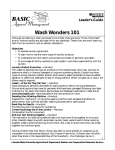
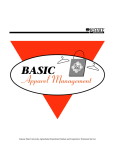
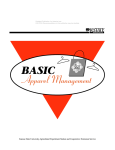
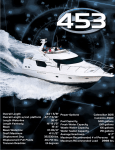
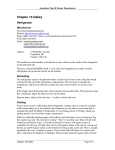
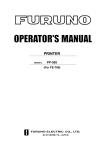

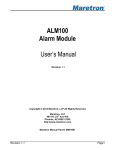
![Corel Office Document [PFP#241512617]](http://vs1.manualzilla.com/store/data/005699212_1-655f6a875c479857ca50d39f97eeaf8f-150x150.png)
